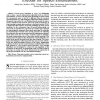Free Online Productivity Tools
i2Speak
i2Symbol
i2OCR
iTex2Img
iWeb2Print
iWeb2Shot
i2Type
iPdf2Split
iPdf2Merge
i2Bopomofo
i2Arabic
i2Style
i2Image
i2PDF
iLatex2Rtf
Sci2ools
TASLP
2016
2016
Unseen Noise Estimation Using Separable Deep Auto Encoder for Speech Enhancement
—Unseen noise estimation is a key yet challenging step to make a speech enhancement algorithm work in adverse environments. At worst, the only prior knowledge we know about the encountered noise is that it is different from the involved speech. Therefore, by subtracting the components which cannot be adequately represented by a well defined speech model, the noises can be estimated and removed. Given the good performance of deep learning in signal representation, a deep auto encoder (DAE) is employed in this work for accurately modeling the clean speech spectrum. In the subsequent stage of speech enhancement, an extra DAE is introduced to represent the residual part obtained by subtracting the estimated clean speech spectrum (by using the pre-trained DAE) from the noisy speech spectrum. By adjusting the estimated clean speech spectrum and the unknown parameters of the noise DAE, one can reach a stationary point to minimize the total reconstruction error of the noisy speech spectrum....
| Added | 10 Apr 2016 |
| Updated | 10 Apr 2016 |
| Type | Journal |
| Year | 2016 |
| Where | TASLP |
| Authors | Meng Sun, Xiongwei Zhang, Hugo Van hamme, Thomas Fang Zheng |
Comments (0)

